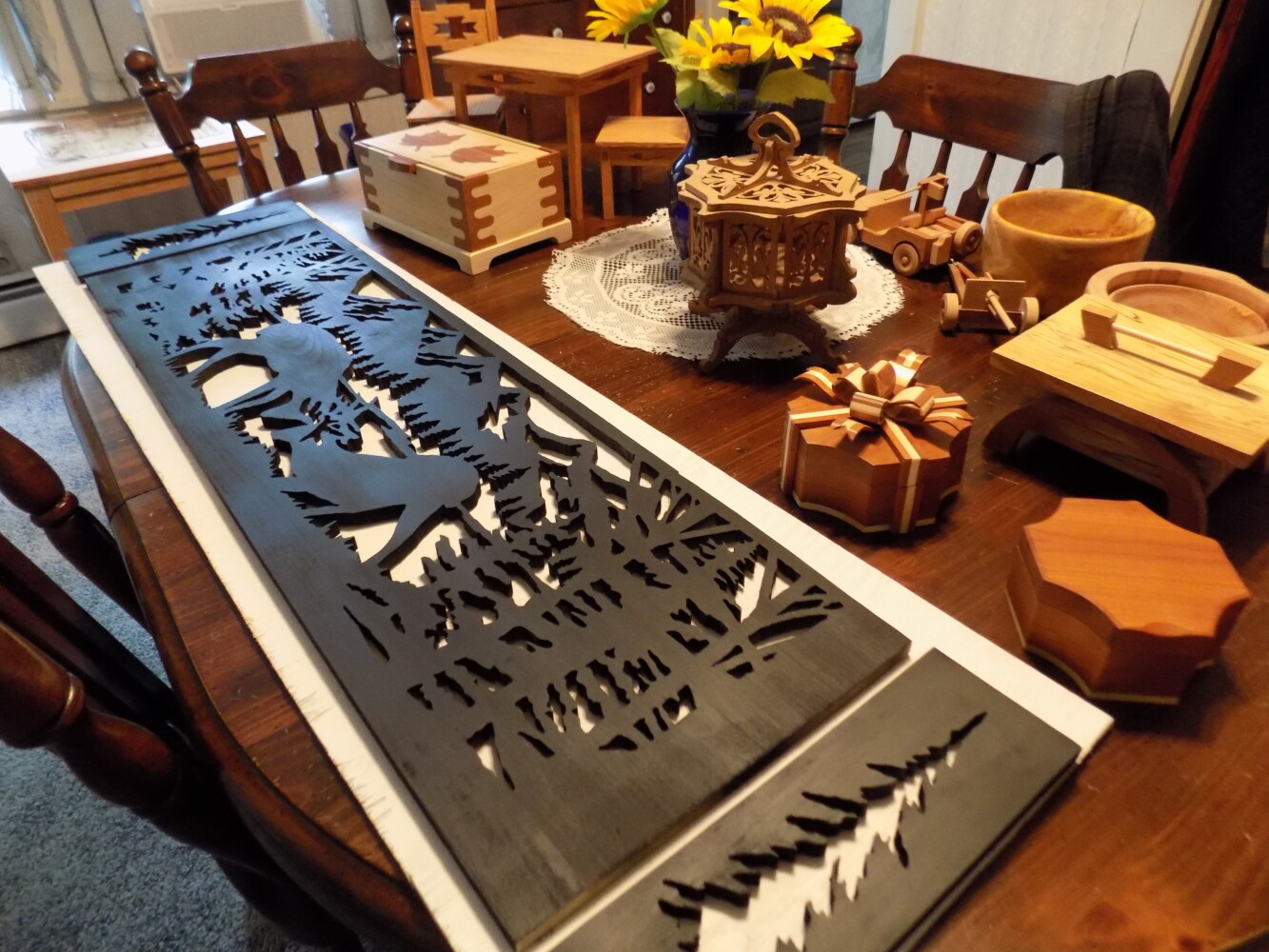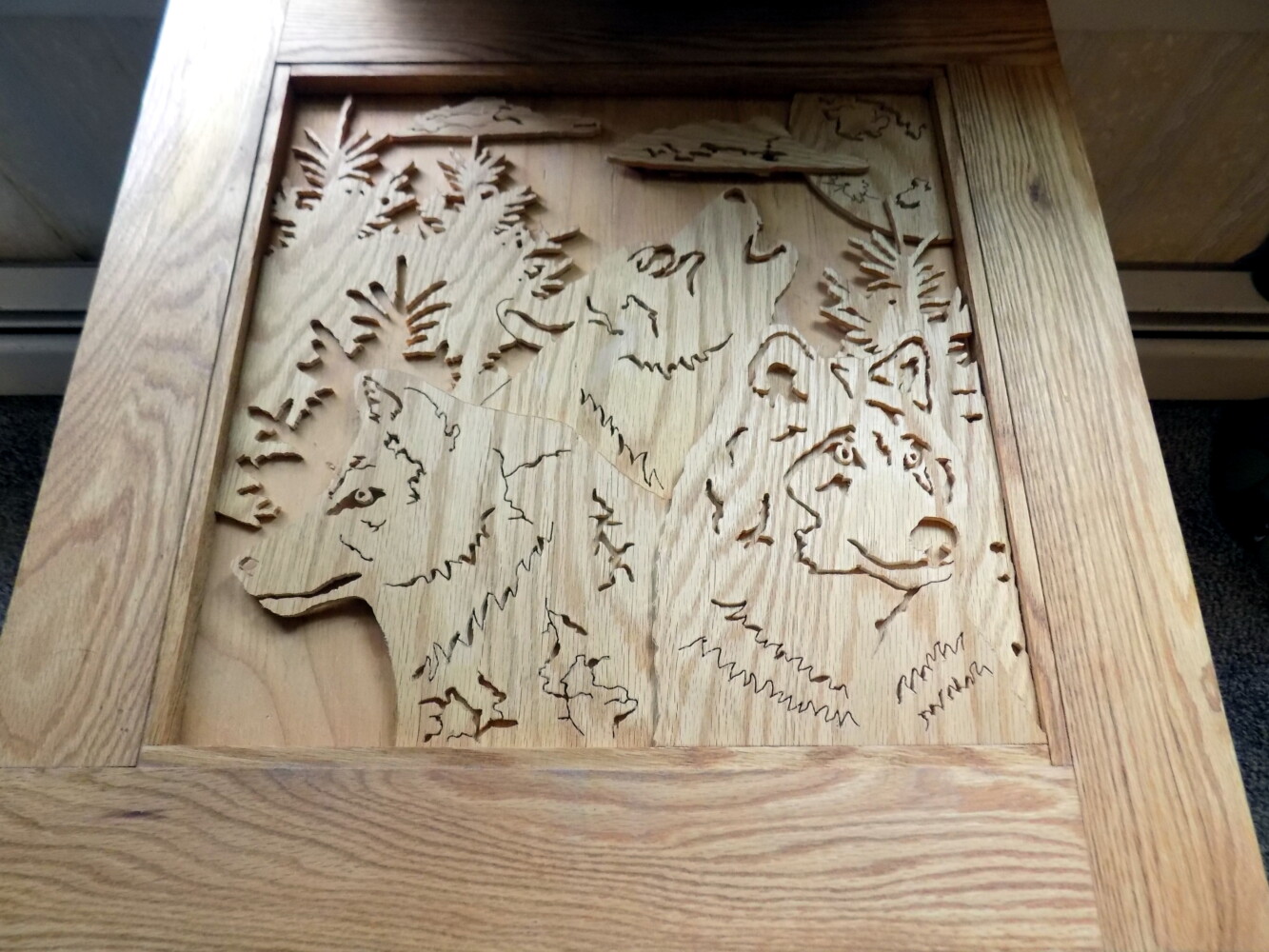
FARMINGTON — Lloyd Smith has been working in the woods for more than 50 years with some of that wood becoming benches, bowls and more.

“Most of the wood comes from things I’ve cut. Whenever we’re cutting wood, whatever catches my eye. A lot of wood has caught my eye over the years,” he said Tuesday, Sept. 1.
On Tuesday, Smith’s dining room table was covered with bowls, a variety of covered boxes, children’s toys and an intricately etched wall hanging. A large bench took up one wall while tables and a display cabinet filled other parts of the room. All were created by Smith.

Smith and his son, Matthew, have been logging together for decades. The explosion at the Jay mill has slowed demand.
“I remember my first time going into the woods. I was always at the neighbors during the summer. One of their boys was my age,” Lloyd Smith said. “We couldn’t hay so we went into the woods, started cutting with a cross cut ax. I still remember that to this day. We cut a big hemlock, we had to peel it. It’s not easy. Hemlock bark is thick.
“I was 10 or 12 then. It’s still fun today.”
Smith calls working in the woods his hobby.
“We’ve seen stuff in the woods most people will never see in their lifetime. I’ve seen hundreds of deer through the years, but it’s still magic when I see them in the woods,” he said. “It’s a thrill to stop and watch them.”
Matt has the first bookcase Smith made.
“It all started … whenever I had a chance, I’d go downstairs and start making something,” the elder Smith said.
Smith said he uses patterns for much of his work. The first box he made has a flower on the cover and uses 2 pegs to line it up with the bottom. Getting the pegs and holes aligned was challenging, he said.

“Now I add another piece to the underside of the top to keep the boxes together. I mark them to know how they are to fit,” he added.

When making those boxes, large pieces are cut out of the bottom part.
“I’ve got a bunch of the insides, what do I do with them? I started taking the insides of bigger boxes, cutting them down and making smaller boxes to save waste,” Smith said. “I still have some waste.”
His father was a finish carpenter.
“He said one time, ‘You can always tell a good carpenter because you can never find his mistakes. He knows how to cover them up.’ That’s how I got started. We always had a circular saw, woodworking tools around the house,” Smith said. “One of the biggest things I regret, I’m not sure regret is the right word, is he knew the basics of how to do things when he died. He took some little things with him that he had learned, that worked for him, with him. I figure that’s a loss now.”
A display case Smith made for the dining room was to put some pretty glass pieces in.
“It’s too bad to hide them all,” he said.

“Anything I make is never as good as I’d like it. There’s always something wrong with it. It’s one of a kind, not like it is manufactured,” Smith said.
He pointed to a table he had made as an example.
“That was quite a challenge. I don’t know what I did wrong. Those 2 drawers are supposed to meet each other according to the plans. It didn’t work, I had to come up with some way to make it work. That’s why there’s an upright between the drawers,” Smith said. “To me, I like it like this.”
One bowl Smith created is not turned.

“It’s segmented, I guess you’d call it. You keep cutting rings out of an 8 x 8 board, gluing them back together,” he said.
Another bowl is made from ambrosia maple.
“The ambrosia bug stings the wood, mainly white maple. It’s strange, we found ambrosia maple in and around very small bogs. The last 2 winters we’ve been working in a big bog, we didn’t find one ambrosia there. Evidently they like the smaller bogs,” Smith said.
According to the Rare Woods USA website, “Ambrosia maple is a general term attached to a variety of Acer (true maple) species whose boards include colorful bug “trails” — caused by a fungus carried by the Ambrosia Beetle which penetrates the tree sap as the beetle eats into the tree, and it spreads both through the worm hole and up and down in the tree (carried along by the sap) and causes discoloring of the wood in streaks.”
Woodworking is something Smith enjoys.
“If I want something, I usually make it. It takes me some time, sometimes,” he said. “That coffee table got used for the TV, so I had to make a coffee table. I turned that lamp, made that magazine rack.”

Cribbage boards have been donated to the American Legion. Many creations have become Christmas gifts. Some pieces were at Sugarwood Gallery. Mainestone Jewelry carries Smith’s work. When he has time to make it, an end table will be found at Vera’s Iron and Vine.

“I’m trying to get up a little woodworking business. My biggest fear is I’ll have too many orders and then I can’t fulfill them. I will take orders as my time permits,” he said.
Woodworking isn’t Smith’s only creative endeavor.
Many cross stitch pieces done by Smith are framed and take pride of place on the walls of his home. Several follow native American or nature themes.
“That one of a boy and his horse and the deer are two of my favorites. The boy one was really fun to do,” he said.
For more information, contact Smith at 207-778-4687.
